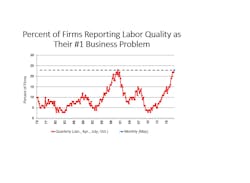May jobs: Wages rise as unemployment falls to 2000 rate
Record high levels of small business owners are reporting increased employee compensation and hiring numbers continue to grow, according to NFIB’s monthly Jobs Report for May. This comes as U.S. unemployment has fallen to the lowest level since early 2000, the Labor Department said Friday.
Specifically, NFIB found that a seasonally adjusted net 35% of small business owners reported increases in labor compensation as owners try to attract needed employees and retain those already on board. And 58% of respondents indicated they are hiring or trying to hire, up one point in the past month and five points since the March report.
“This month’s jobs report demonstrates that small business owners’ optimism is showing no signs of abating. They are increasing compensation at record levels and are continuing to hire,” said NFIB President and CEO Juanita Duggan. “Post tax reform, concerns about taxes and regulations are taking a backseat to their worries over filling open positions and finding qualified candidates.”
While near record high levels of owners are hiring or trying to hire, 83% of respondents reported few or no qualified applicants for the positions they were trying to fill. And 23% of owners cited the difficulty of finding qualified workers as their Single Most Important Business Problem (up one point), the highest reading since 2000, and one point below the all-time survey high.
Thirty-three percent of all owners reported job openings they could not fill in the current period, down two points but historically very high. Twelve percent reported using temporary workers, unchanged.
“While the small business economy is showing tremendous growth, difficulty finding qualified workers continues to be a notable issue,” said NFIB Chief Economist Bill Dunkelberg. “Temporary workers are filling some of these vacancies, but an increased availability of qualified workers would lead to more growth in employment.”
Click here to view the entire NFIB Jobs Report.
Meanwhile, the Bureau of Labor Statistics monthly employment summary showed the U.S. economy added 223,000 jobs in May, exceeding forecasts. The unemployment rate edged down to 3.8% as employment continued to trend up in several industries, including retail trade, health care, and construction.
Manufacturers added 18,000 workers in May, extending the 25,000 gain in April. Durable goods accounted for most of the change, including an increase of 6,000 jobs in machinery. Manufacturing employment has risen by 259,000 over the year, with about three-fourths of the growth in durable goods industries.
Average earnings for U.S. workers rose by 8 cents an hour, up 2.7% over the past 12 months, the government reported.
“The latest jobs numbers confirm that the labor market has tightened significantly, with manufacturers increasing employment by nearly 19,000 per month on average since the end of 2016,” said Chad Moutray, chief economist for the National Association of Manufacturers (NAM). “That is quite a turnaround from the sluggish job growth in 2016, and it is a sign that firms have continued to accelerate their hiring as the economic outlook has strengthened and demand and production have improved considerably.”
About the Author
Kevin Jones
Editor
Kevin has served as editor-in-chief of Trailer/Body Builders magazine since 2017—just the third editor in the magazine’s 60 years. He is also editorial director for Endeavor Business Media’s Commercial Vehicle group, which includes FleetOwner, Bulk Transporter, Refrigerated Transporter, American Trucker, and Fleet Maintenance magazines and websites.
Working from Beaufort, S.C., Kevin has covered trucking and manufacturing for nearly 20 years. His writing and commentary about the trucking industry and, previously, business and government, has been recognized with numerous state, regional, and national journalism awards.

